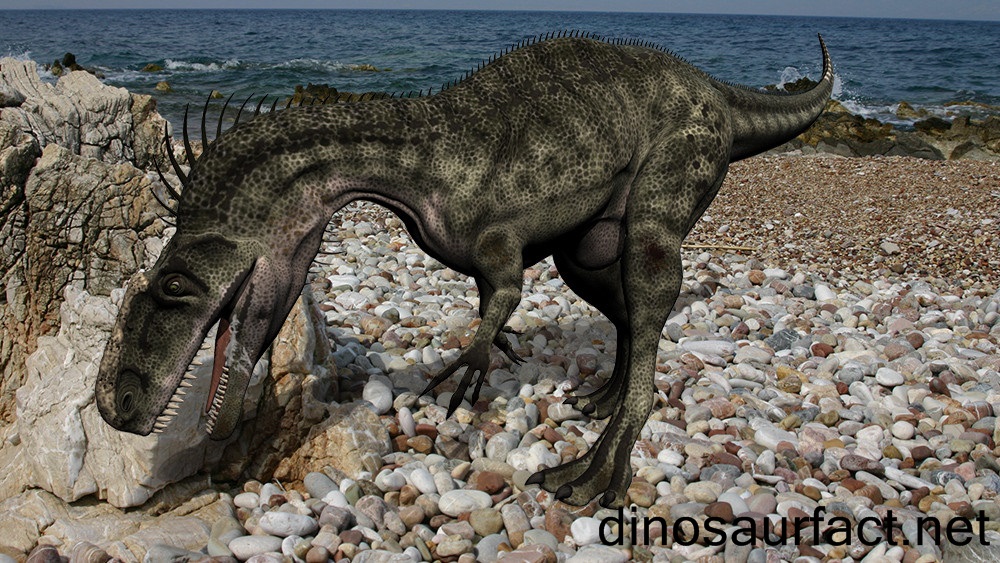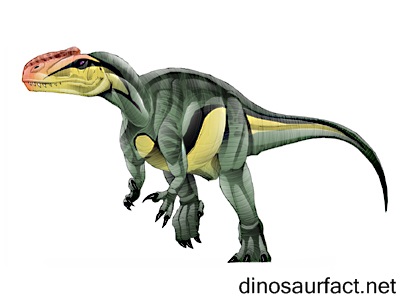 Click to visit the previous dinosaur bio
Click to visit the previous dinosaur bio
 |
|
 |
|
Kingdom: Animalia
Phylum: Chordata
Class: Sauropsida
SuperOrder: Dinosauria
Order: Saurischia
SubOrder: Theropoda
Family: Megalosauroidea
Genus: Monolophosaurus
 |
|
 |
|
 |
|

The word 'Monolophosaurus' means single crested lizard. Monolophosaurus was a medium sized theropod dinosaur. They existed during the Middle Jurassic period. This dinosaur was named so because of the presence of a distinct single crest on its skull.
The only species known till date is Monolophosaurus jiangi. Fossil studies show that these lizards generally measured five meters in length and weighed something around one thousand and five hundred pounds. It is believed that Monolophosaurus generally hunted in packs although scientific evidence is still lacking. Fossil studies indicate them to be crested dinosaurs like Dilophosaurus and they were related. Monolophosaurus was a close relative of advanced tetanurans. Monolophosaurus was known to have sharp and serrated teeth. The places where their fossils were found showed signs of water. Hence it can be inferred that these species generally inhabited shores of oceans and lakes.
- An almost complete skeleton of Monolophosaurus was discovered in the Canadian-Chinese expeditions (1981-1984). This fossil was however anonymous until Dong Zhiming in 1992 and Wane Grady in 1993 named this fossil as Monolophosaurus. However these namings lacked proper descriptions and hence were considered invalid. In 1993-94 finally Zhao Xijin and Philip John Curie named and described Monolophosaurus jiangi.
- The genus name comes from the presence of single crest on the snout. And the species name has its reference from Jiangjunmiao. This is the name of temple (locally called miao) of the general ( named jiangjun). Local folklore suggested the body of the general was found there.
It should also be mentioned that there has been a discovery of a holotype IVPP 84019 in Junggar Basin. It was discovered in the layer of Wucaiwan Formation which dates back to the Batonian-Callovian ages. This skeleton was quite complete. It had skull, lower jaws, vertebral column and pelvis. However the set up lacks the presence of the end portion of the tail and the limbs. Studies suggest that this should have been that of an adult or a sub-adult.
In later years however this specimen was restored with plaster and was rather used for exhibition at different places. Unfortunately the left side of the fossil was enclosed in foam and this obstructed further studies. In later years with the help of experts the missing elements of the fossil were restructured into complete skeletal casts.
- Thomas Carr in 2006 also suggested from his studies Guanlong, a similar theropod with a thin, large and fenestrated crest present at the midline hailed from the same formation. He further suggested that this could have been a sub adult individual of Monolophosaurus. For quite some time Guanlong had been considered to be belonging to the proceratosaurid tyrranosaurid clan. Carr did an in-depth comparison of both the fossils and clustered them. He then concluded that they belonged to the allosaurid family.
- Later in 2010 Gregory S Paul further went on to rename Guanlong into Monolophosaurus wucaii . He had presumed that the taxa might be belonging to the sister species.
- Later Brussate et al in the same year rejected the idea and pointed out that Guanlong was a full grown adult individual.
- In 2009 there also has been an analysis of the post cranial skeleton by Zhao et al. He noted down several primitive traits in the fossil skeleton for instance the shape of the ilium. He thus concluded that Monolophosaurus belonged to the basal tetanurans.
Several distinguishing features have been observed in the fossils of Monolophosaurus. There is the presence of a large crested snout on the midline. This crest was formed from the Premaxilla and it continued over the nasals and lacrymals and the rear almost touched the frontals and is parallel to the upper jaw edge. The ascending premaxillary branches have a forked ending. Another distinguishing feature is the presence of a premaxillary deep groove present over an opening in the ascending branch and ending towards an opening just below the nostrils. There is also the presence of two unequal sized pneumatic openings within the depression and around the upper rear nostril. There was also the presence of a hatchet shaped process that was somewhat pointing upwards and was located just at the rear branch of the lacrimals and above the eye socket.
It is interesting to note that the holotype skull was somewhat flat in shape but was almost reconstructed shape wise by the large snout. This snout covers almost three quarters of the skull and spreads almost up to the eye socket. Studies have revealed that the crest starts from the snout tip of the premaxilla and it is also observed that they are formed of nasal bones. This crest has a triangular cross section in the transverse end and is characterized with a broader base and a narrower but flat upper surface. The upper rear part of the depression that is formed around the antorbital fenestra is due to the nasal bones. Pneumatic openings characterizing the presence of diverticula of air sacs were abundant within this area. Two small foramina are also present in this portion. Basically advanced studies have revealed that the nasal bone and even the jugal bone were heavily hollow or pneumatised. They had an I-shaped lacrimal and a small horn was even present behind the eye socket.
The vertebral column was having nine cervical, fourteen dorsal and five sacral vertebrae. However it is worth mentioning that the number of tail vertebrae remains unknown till date. However biophysical studies suggest the tail base to be in a slightly downward orientation.
The pelvis is characterized by the presence of a convex ilium that has a hook shaped front blade. There has been no evidence regarding the presence of the brevis shelf. The pubic bones and the Ischia are quite interestingly similar to each other as each and e very pair of them are connected by bony skirts and are pierced through by a foramen.
To conclude however it is disheartening to see that Monolophosaurus has not grabbed the eye candy status of the general public when compared to its cousin Dilophosaurus. Though both of these dinosaurs belong to the Allosaurus clan, Monolophosaurus was considered to be slightly bigger in size when compared to Dilophosaurus and probably a more dangerous theropod.
Index
Extinct Profiles
 Triassic Dinosaurs
Triassic Dinosaurs Jurassic Dinosaurs
Jurassic Dinosaurs Cretaceous Dinosaurs
Cretaceous Dinosaurs Pterosaurs
Pterosaurs Marine Reptiles
Marine Reptiles Dinosaur Extinction
Dinosaur Extinction